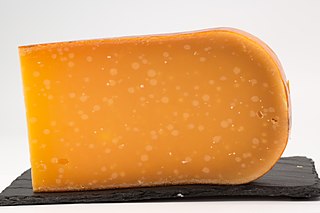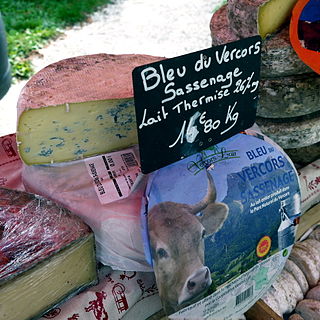Related Research Articles

Gouda is a mild, yellow cheese, originating from the Netherlands, made from cow's milk. It is one of the most popular cheeses worldwide. The name is used today as a general term for numerous similar cheeses produced in the traditional Dutch manner.

Halloumi or haloumi is a semi-hard, unripened, brined cheese made from a mixture of goat's and sheep's milk, and sometimes also cow's milk. It has a high melting point and so can easily be fried or grilled. Rennet is used to curdle the milk in halloumi production, although no acid-producing bacteria are used in its preparation.

Goat cheese, goats' cheese, or chèvre, is cheese made from goat's milk.

Leipäjuusto or juustoleipä, which is also known in the United States as Finnish squeaky cheese, is a fresh cheese traditionally made from cow's beestings, rich milk from a cow that has recently calved. Reindeer or even goat milk can also be used. Commercially available versions are typically made from cow's milk, and they lack some of the colour and flavour because of this. The cheese originally comes from Southern Ostrobothnia, Northern Finland, and Kainuu.

Tilsit cheese or Tilsiter cheese is a light yellow semihard smear-ripened cheese, created in the mid-19th century by Prussian-Swiss settlers, the Westphal family, from the Emmental valley. The original buildings from the cheese plant still exist in Sovetsk, Russia, formerly Tilsit, on the Neman River, formerly Memel, in the former German province of East Prussia.

Fontina is an Italian washed-rind cow's milk cheese. Fontina has PDO status under European law.
Parrano cheese is a cow milk cheese produced in the Netherlands. It tastes mild and nutty, combining salty and sweet flavours. It has a semi-firm texture and a smooth, golden coloured paste. Made from pasteurized milk, Parrano is produced in 20 lb (9.1 kg) wheels and is aged for 5 months.

Bleu du Vercors-Sassenage is a mild pasteurized natural rind cow's milk blue cheese originally produced by monks in the Rhône-Alpes region of France in the 14th century. Now made in the Dauphiné area, the cheese has been a protected Appellation d'Origine Contrôlée since 1998. As a requirement, the cheese has to be composed of milk from Montbéliard, Abondance or Villard cows. The cheese is unpressed and uncooked and contains the mold Penicillium roqueforti. In Larousse's Grand Dictionnaire Universel of the 19th century, King Francis I is described as being quite fond of the cheese.

Cheese is a dairy product derived from milk that is produced in a wide range of flavors, textures, and forms by coagulation of the milk protein casein. It comprises proteins and fat from milk, usually the milk of cows, buffalo, goats, or sheep. During production, the milk is usually acidified, and adding the enzyme rennet causes coagulation. The solids are separated and pressed into final form. Some cheeses have molds on the rind, the outer layer, or throughout. Most cheeses melt at cooking temperature.

Types of cheese are grouped or classified according to criteria such as length of fermentation, texture, methods of production, fat content, animal milk, and country or region of origin. The method most commonly and traditionally used is based on moisture content, which is then further narrowed down by fat content and curing or ripening methods. The criteria may either be used singly or in combination, with no single method being universally used.
Dovedale, sold as Dovedale Blue, is a blue cheese. It is named after the Dovedale valley in the Peak District, near where it is produced.
Maaslander is a brand name for a Gouda, semihard cheese from Westland Cheese Specialties BV from Huizen, the Netherlands. Maaslander is one of the first Dutch cheese brands, and it is a protected designation of origin. Including the green and yellow stripes, and also the name lander.
Béal Organic Cheese is the first organic cheddar cheese in Ireland. The cheese won a silver medal at the World Cheese awards in 2009.
References
- ↑ Miller, Laurel; Skinner, Thalassa; Ming Tsai (2012). Cheese For Dummies. John Wiley & Sons. p. 210. ISBN 9781118099391.
- ↑ Koene, Ada Henne (2006). Food Shopper's Guide to Holland . Eburon. p. 41. ISBN 9789059720923.
- ↑ Koppenol, Johan (1998). Leids heelal: het Loterijspel (1596) van Jan van Hout. Verloren. p. 21. ISBN 9789065500328.